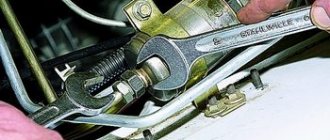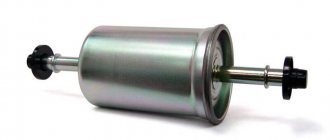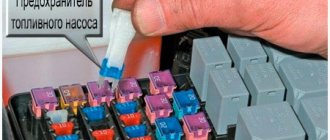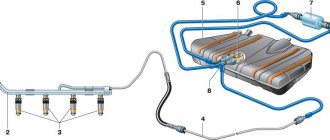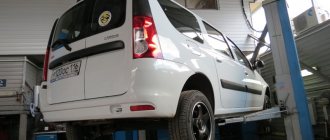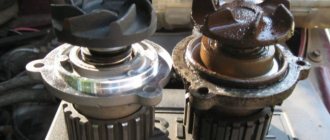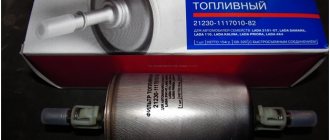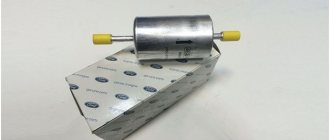The filter is an important component of the fuel system of a vehicle - the life and service life of the power unit and adjacent vehicle systems directly depends on the quality of purification of the incoming fuel.
That is why it is necessary to change the fuel filter in a timely manner, adhering to the conditions of scheduled maintenance and the car manufacturer’s regulations.
As is correct, when replacing an old filter, drivers choose foreign-made options - the original filter on the Niva has a short lifespan and quickly becomes clogged.
The most popular fuel filter models for Niva are presented in the table below. All parts comply with the stated standards of the official manufacturer.
| Manufacturer | Country of Origin | Part number | Approximate cost, rub. |
| Romania | ASAM | 30524 | 260 |
| Romania | ASAM | 30543 | 275 |
| Italy | STARLINE | SF PF7012 | 350 |
| Italy | STARLINE | SF PF7043 | 370 |
| France | PURFLUX | EP163 | 370 |
According to the automaker's regulations, the fuel filter on the Niva must be changed every 30,000 km. However, the need to replace the part may arise much earlier - if low-quality fuel is poured into the car or the car is driven on dusty or dirt roads, then the filter needs to be changed every 15,000 km.
Remember, the service life of the engine depends on the timely replacement of this element; a clogged filter significantly speeds up the production of engine components.
Note! It is strictly not recommended to install a fine filter on a car, especially when refueling the vehicle with low-octane fuel. The fine filter does not provide adequate filtration quality, as a result of which small abrasive elements and chips can get into the internal combustion chambers of the engine, which will reduce the service life of the engine. This type of tuning is not compatible with the domestic auto industry!
Replacing the fuel filter Niva 2131 injector
How often to change the fuel filter? – According to the regulations, replacement must be carried out every 30 thousand km.
mileage However, if the car is operated in dusty conditions or low-quality fuel is used, then replacement must be done more often. Where is the fuel filter located? – If the filter meets Euro-2 toxicity standards, then it is installed in the engine compartment on the left front mudguard under the spare wheel.
– If the filter meets Euro-3 toxicity standards, then it is installed under the bottom of the car, in a recess, above the additional muffler.
We carry out the work on a cold engine.
You mean that the fuel in the power system (with the ignition on, as well as for some time after) is under pressure. Therefore, before replacing the fuel filter, the pressure must be relieved. If the car’s ignition has not been turned on for more than 3 hours, then there is usually no pressure in the fuel system. You can check the pressure by unscrewing the cap of the fuel rail fitting and pressing the spool rod. (see here)
You also need to keep in mind that the filter is located below the level of the fuel tank and when it is removed, fuel can flow out of the tank through a tube disconnected from the filter. Therefore, you need to have a container to collect fuel.
To relieve pressure in the system, remove the lining of the left front sidewall (see here).
We disconnect the connectors connecting the wiring harness of the engine management system and the rear wiring harness.
We start the engine and let it idle until the fuel runs out. Then turn on the starter for 2-3 seconds. After this, the pressure in the power system will be released.
Disconnect the negative cable from the battery.
To remove the filter under the bottom (Euro-3)
To remove the filter under the hood (Euro-2)
Remove the spare wheel support bracket.
Holding the filter with a 19mm wrench, use a 17mm wrench to unscrew the fuel pipe fitting, gradually bleeding the gasoline into the substituted container.
We remove the fuel pipe from the filter. Similarly, disconnect the fitting of the second tube.
Each tube has a rubber O-ring, which we replace with a new one if damaged.
Use a 10mm wrench to loosen the clamp bolt.
. and remove the fuel filter.
Install the filter in reverse order.
The arrow on the new fuel filter should point toward the rear of the vehicle (in the direction of fuel flow).
Having installed the new filter, we connect the connection block between the engine management system wiring harness and the rear wiring harness.
We check the tightness of the connections with the engine running.
Video
Reg.: 04/05/2009 Messages: 419 From: Taganrog Age: 55 Car: Jeep, VAZ 21214M 2009
Reg.: 08/31/2010 Messages: 50 From: Kuznetsk Age: 32 Car: 21214 2007, VAZ21063, Izh-27175-40, bmw523i,
Name: Ilya Reg.: 12/20/2009 Messages: 456 From: RB Ufa Age: 30 Car: VAZ 21214-020-046 November 2009
CJla8ok
an ordinary tire monomer will not work. You need one with a cone. From the pictures you will understand what is where. In the first picture there is a number 2. I don’t know what is written in your manual, but in my service book it says 40 thousand. I change it every 10k, but this is purely my opinion, otherwise there will be supporters here that you shouldn’t change it so often, and the screen on the fuel pump every 20k. I don’t do all this on my first car. I don’t force you to do this, do it as you please, or according to the manual. and the pressure is checked when all the filters are changed, and the car still doesn’t work and takes a long time to start. Go to any auto store and ask. You need a pressure gauge to measure the pressure in the fuel line.
Done according to regulations or in case of failure. In terms of time, it takes from 30 minutes (if suspended) and up to 4 hours if changed by removing the tank.
The cost of replacing a VAZ 2131 fuel filter depends on its installation and the complexity of the work. The easiest way is to change an element installed in the engine compartment or an outboard element embedded in the highway.
Price:
Car services in St. Petersburg:
Kupchino
– 245-34-84
Citizen
– 603-55-05
Bolsheviks
–
WhatAapp/Viber: 8-911-766-42-33
If it is installed in the gas tank, then there are two replacement options. If there is a service hatch under the rear seat, that's good. If there is no hatch, then you can either cut it out or replace it by removing/installing the fuel tank.
The main signs of a TF malfunction:
– fuel consumption has increased sharply; – the car began to stall at idle; – the engine is running rough, the ignition system is in the room; – car jerking when going uphill.
If necessary, we can also change the fuel pump and measure the pressure in the rail.
Diagnostics of the fuel system during repairs with us is free!
Addresses in St. Petersburg: Service station on Bolshevikov: st. Voroshilova, house 7, from 10 to 18, t. 8 (812) 701-02-01, Sat, Sun – closed. Service station on Grazhdansky: st. Uchitelskaya, building 23, from 9.30 to 21.00, t. 8 (812) 603-55-05, seven days a week. Service station on Kupchino: st. Dimitrova, building 1, from 10 to 20.00, t. 8 (812) 245-34-84, seven days a week.
How to replace the fuel filter on a Niva Chevrolet?
To extend the life of your car, filter elements must be changed at least every 30,000 kilometers. In our conditions, which Europeans consider extreme (dirt dusty roads, low quality gasoline, gas pollution in megacities), it is better to halve this period. Replacing a Chevrolet Niva fuel filter is one of the most important aspects of car service, because the condition of the car’s power unit largely depends on it.
Attention! When working with the fuel system of your car, do not smoke under any circumstances, and replacing the filter element should be carried out as far as possible from gas stoves, stoves and other appliances.
Filter
Attention! The engine system is under high pressure; therefore, after stopping it, loosening the fuel drives is strictly prohibited. After turning off the engine, you must first reduce the pressure before starting work on the power system. It takes about three hours for the pressure to drop to zero.
How to reduce pressure in the engine power supply system?
Method No. 1
- Unscrew the nut securing the cover of the engine control unit - it is located inside the passenger compartment.
- Remove the cover.
- Remove the fuse for the electric gasoline pump.
- Turn on the engine, it should run until all the fuel in the fuel line is exhausted. When this happens, the engine will stall on its own.
- Reinstall the fuse.
Method number 2
You can reduce the pressure using the control valve, which is located behind the fuel rail; it is closed with a cap (usually made of plastic). The design of the valve is similar to a wheel spool.
Unscrew the cap and drain excess fuel by simply pressing the valve.
Disconnection of the fuel wires is possible only after this procedure. Be extremely careful! Gasoline will come out under pressure.
Main signs of a clogged or broken fuel barrier
The most common signs:
- When the engine warms up, extraneous noises are heard. They may appear periodically.
- When driving uphill, the engine becomes difficult to operate.
- The power unit operates jerkily.
- Increased fuel consumption.
- The engine does not start.
Where is the filter located?
The fuel filter element in a Niva Chevrolet is located at the bottom of the car at the rear, next to the right wheel and is covered with a plastic casing.
Replacement process
Work to replace the filter barrier must be carried out on a lift, pit or overpass.
Where are the coarse and fine cleaning elements located?
The first filter element in the form of a mesh is installed directly on the fuel pump. It prevents dirt from getting into the pump mechanism and fuel line. Preparatory filtration extends the life of the fine filter.
The placement of the filter element for narrow cleaning depends on the year of manufacture of the car. Before the restyling of the Chevrolet Niva, a narrow filter was installed under the hood.
On models starting from 2009, it is located under the bottom in the rear of the machine. To find the part, you need to remove the plastic cover near the right wheel.
We replace the Niva Chevrolet fuel filter with a new one.
To set a Chevrolet Niva SUV in motion, it is necessary that high-quality fuel enters the engine. But before it gets into the gas tank of a car, the fuel travels a long way from oil refineries to gas stations, moving in fuel tankers and pipelines along the way. Then it is stored in an underground container, waiting in the wings. On this path there is a high risk of various small debris, water and other particles getting into it. Over time, condensation may also form in the gas tank. If all this gets into a running engine, then there is a high probability of increased wear of parts and mechanisms. Therefore, such a necessary part as the Niva Chevrolet fuel filter is installed so that the quality of the mixture can be adjusted.
Replacing the fuel filter on a Chevrolet Niva is a fairly simple procedure that can be done independently. Let us consider in more detail the purpose of this part and the main prerequisites for its replacement.
Filter location
This element is built into the fuel line between the tank and the injectors. It is necessary to prevent particles of debris, dust, rust, etc. from entering the combustion chamber.
To ensure maximum cleaning, there was no need to frequently replace components in cars with a two-factor system consisting of a coarse and fine filter.
- Coarse cleaning - needed to retain particles with a size of 0.1 mm. It is a fine-grained mesh, which is made mainly of brass. The device is located near the gas tank. In the Chevrolet Niva it is built into the fuel pump. This product can be cleaned by washing, so there is no need for frequent replacement.
- Fine cleaning – designed to remove dust and impurities up to 0.001 millimeters in size. This is a cylindrical device, inside of which material with small fractions is placed. Installed between the pump and the fuel rail. It usually fails more often, but replacement is quite simple.
To watch online, click on the video ⤵
Replacing the fuel pump on a 4x4 field More details
the smell of gasoline in the interior of the Niva Read more
Replacing the Chevrolet Niva fuel filter Read more
REPAIR VAZ 2114 | REPLACING THE FUEL FILTER More details
Why do you need to change the fine fuel filter and why is it needed Read more
New fuel pump for the field Read more
Engine power will immediately increase after installing the filter | Garage myths Read more
Replacing the fuel filter in the tank, what you should pay attention to Read more
Do-it-yourself replacement of the fuel pump mesh on the injector More details
The smell of gasoline in the car interior. All the reasons. Elimination of gasoline leaks. VAZ Lada Niva 4x4 1st part Read more
Replacing the fuel pump mesh and fuel filter on a VAZ 2110 2115 Read more
ICE killer. Mine in VAZ NIVA. Acoustic pipe. How to remove the acoustic pipe of Niva Lada 4×4 Read more
Fatal error! When changing the oil according to the instructions. Correct oil change in internal combustion engines, gearboxes, manual gearboxes, Axles Read more
Low fuel pressure, what's the problem Injector!? VAZ Read more
All VAZ Sensors Location. All VAZ NIVA drivers need to know this. DPS, DMRV, DPKV, DPRV, IAC Read more
Replacing the fuel filter on VAZ 2110, 2111 and 2112 injector Read more
REPLACING THE FUEL FILTER FOR A CHEVROLET NIVA (Chevrolet NIVA) More details
Cabin filter for Niva 2121, 2131 Read more
Replacing the fuel filter Niva 21214 More details
NIVA CLUB
International Niva Club
- List of forumsAuto - EquipmentConsumables and expenses.
- Search
- Links
- Unanswered topics
- Search
- Online store "NIVA SHOP"
Active topics
Fine fuel filter
Fine fuel filter
Post by elwolk » Aug 27, 2012, 10:15 pm
The fuel filter often gets clogged; gasoline in the region is excellent. (niva injection) I opened a couple of filters of different brands with a hacksaw, inside there is a completely different device. In one there was a piece of paper stupidly across, and with a little effort it stood along the O_o filter, so it became end-to-end. The filter of another brand had a completely different device, which was incomprehensibly metal.
What filters should you give preference to, what do you think?
Re: Fine fuel filter
Post by doc Brown » Aug 28, 2012 00:52
Re: Fine fuel filter
Post by senin » 08 Oct 2012, 20:31
Re: Fine fuel filter
Post by Chukot53 » Jan 18, 2013, 6:02 pm
Re: Fine fuel filter
Post by senin » Jan 18, 2013, 7:15 pm
Re: Fine fuel filter
Post by doc Brown » Jan 28, 2013 10:24 pm
Not such a good thing, as it turned out. I had it in front of the gas pump for about a year; the actual mileage on gasoline during this time was five thousand.
In winter. In addition to warming up before switching to propane, I had to travel on more gasoline, because in Murmansk there was no gas at gas stations for a month and a half. Therefore, I took a closer look at the gasoline power system. During the New Year holidays, I set out to finish up the secondary chamber of my carburetor. It overfills it with gasoline when opening it, and therefore, instead of the expected acceleration, a “dulling” is observed. But now we are not talking about the selection of jets. When opening the carburetor, rust was found in the float chamber, which made me very upset.
The filter was temporarily replaced with a regular plastic sump and mercilessly sawed apart.
A similar filter, which had been standing for two years on a heavily used Opel Vectra, was also sawn apart. It turned out to be clean inside. This hardly says anything about its filtering abilities. Rather, it’s about the fact that the tanks on Opels don’t rust (the car is from 1992).
After driving for a week with a plastic filter, I again found traces of rust in the float chamber. But this filter was not expected to be particularly impenetrable. Based on the experience of my old cars, the best way to combat rust is by weight, not size. Therefore, after the fuel pump, I installed a fine filter from an old Volga, with a deeper sump.
The experiment is not over yet. The process of selecting jets continues, so I’ll look into the carburetor again. If necessary, I will install a ZiLovsky coarse settling filter. Its effectiveness in fighting off rust is very difficult to overestimate.
Re: Fine fuel filter
Posted by bearthe » May 13, 2013, 11:39 am
Option 1 is correct. 1. Drain the fuel from the tank 2. Remove the tank After this: 1. Visually check the tank for rust. if there is, clean it. You may have to fill the tank with water and boil the holes. DO NOT COOK EMPTY UNDER ANY CASE! 2. Unscrew the fuel intake, shine an LED flashlight inside, and be horrified by the layer of dirt. 3. Wash everything thoroughly, “unscrew” the tank, or use a drain plug (I don’t recommend it - then you won’t screw it tightly for anything. The tank is old - it’s ruined by metal). 4. Place the heel on the fuel intake (coarse filter - does not allow water and dirt to pass through). Buy a normal one, check it directly on the market. 5. Completely replace the fuel line. Place the filter vertically - supply from below, intake from above. (the arrow should point up) 6. Install a new normal coarse filter. (and change it every 5,000 - 7,000 thousand) 7. Install a new normal air filter - for example, a zero filter (but you will have to take a corrugation, a turtle for it and sculpt a pan yourself - without it it’s not comme il faut.) and impregnation for it. Service it once a week. 8. Completely disassemble and wash the carburetor with carbcleaner, replace the coarse filter in the carburetor intake, check the jets and float. The fuel system is ready for operation.
Option 2 is incorrect. Temporary solution.
1. Place the heel on the fuel intake of the gas tank (coarse filter - does not allow water and dirt to pass through). Buy a normal one, check it directly on the market. 2. Unscrew the line from the tank, the other end from the filter in the engine compartment, point it in the direction “somewhere so that it doesn’t get on anyone,” ask a friend to hold it. 3. Take the compressor and blow out the line (a fair amount of Mr. will fly out of it), first at a pressure of 4 atm, then at 8 atm. 4. Install a new normal coarse filter. (and change it every 3000 - 5000 thousand) 5. Completely disassemble and wash the carburetor with carbcleaner, replace the coarse filter in the carburetor intake, check the jets and float. You can somehow drive.
From your photos - in the third photo you can see how much Mr. has settled on the filter (I can imagine how much there is in the line and in the tank). So, what went into the carb is what the filter couldn’t cope with, because... was already clogged and had lost its permissible capacity. Otherwise it would be in the carb, as it will be now when you installed a plastic filter. I went through this and I don’t recommend it to you. Better
and do option 1. Sincerely,
Replacing the fuel filter VAZ 21214 injector Niva
How often to change the fuel filter? – According to the regulations, replacement must be carried out every 30 thousand km. mileage However, if the car is operated in dusty conditions or low-quality fuel is used, then replacement must be done more often.
Where is the fuel filter located? – If the filter meets Euro-2 toxicity standards, then it is installed in the engine compartment on the left front mudguard under the spare wheel.
– If the filter meets Euro-3 toxicity standards, then it is installed under the bottom of the car, in a recess, above the additional muffler.
We carry out the work on a cold engine.
You mean that the fuel in the power system (with the ignition on, as well as for some time after) is under pressure. Therefore, before replacing the fuel filter, the pressure must be relieved. If the car’s ignition has not been turned on for more than 3 hours, then there is usually no pressure in the fuel system. You can check the pressure by unscrewing the cap of the fuel rail fitting and pressing the spool rod. (see here)
You also need to keep in mind that the filter is located below the level of the fuel tank and when it is removed, fuel can flow out of the tank through a tube disconnected from the filter. Therefore, you need to have a container to collect fuel.
To relieve pressure in the system, remove the lining of the left front sidewall (see here).
We disconnect the connectors connecting the wiring harness of the engine management system and the rear wiring harness.
We start the engine and let it idle until the fuel runs out. Then turn on the starter for 2-3 seconds. After this, the pressure in the power system will be released.
Disconnect the negative cable from the battery.
To remove the filter under the bottom (Euro-3)
To remove the filter under the hood (Euro-2)
Remove the spare wheel support bracket.
Holding the filter with a 19mm wrench, use a 17mm wrench to unscrew the fuel pipe fitting, gradually bleeding the gasoline into the substituted container.
We remove the fuel pipe from the filter. Similarly, disconnect the fitting of the second tube.
Each tube has a rubber O-ring, which we replace with a new one if damaged.
Use a 10mm wrench to loosen the clamp bolt.
. and remove the fuel filter.
Install the filter in reverse order.
The arrow on the new fuel filter should point toward the rear of the vehicle (in the direction of fuel flow).
Having installed the new filter, we connect the connection block between the engine management system wiring harness and the rear wiring harness.
We check the tightness of the connections with the engine running.
Video
Fuel
filter Niva
21214 where is
Wrote, date, where,
Replacing the fuel filter
EXECUTION ORDER
We carry out the work on a cold engine.
Disconnect the negative cable from the battery. Remove the spare wheel support bracket.
Holding the filter with a 19mm wrench, use a 17mm wrench to unscrew the fuel pipe fitting, uniformly draining the gasoline into the substituted container.
Replacing the fuel filter Niva 21214
Changing the FUEL filter
for VAZ 2108,2109,2199,2113,2114 and 2115 injector.
Replacement frequency
If the gasoline in the tank does not contain foreign impurities, the coarse filter can work for years. It only needs to be inspected and cleaned if the pressure in the fuel line drops. It also makes sense to wash the mesh with carburetor cleaner during any maintenance. The Chevrolet Niva narrow cleaning filter is designed for 30,000 km. But, taking into account the properties of the fuel, it has to be changed after 15,000.
The need for replacement can be determined by the following signs: • Poor traction when moving uphill. • Intermittent operation of the motor, especially at high speeds and under overload. • Increased fuel consumption. • Difficulty starting the engine.
Restyled Nivas are equipped with GM 21231117010 narrow filters. But there are a huge number of analogues in stores: Bosch 0450905273, Hummel WK512 and others. The cost of parts starts from 400 rubles.
